Presentiamo in anteprima l’attesissimo decreto attuativo del piano Transizione 5.0, attualmente in discussione presso i ministeri, che include tutti i dettagli su come usufruire dell’incentivo: dalle definizioni di struttura produttiva e processo interessato, all’ammorbidimento delle esclusioni per il principio DNSH, dalla definizione dello scenario controfattuale ai limiti di spesa per i pannelli fotovoltaici e i sistemi di accumulo, fino al nuovo elenco dei soggetti abilitati alla certificazione.
Sono inoltre in arrivo le linee guida e l’apertura della piattaforma del GSE.
Definizioni
Impresa di nuova costituzione Le prime definizioni significative riguardano le imprese di nuova costituzione. Queste possono fare riferimento a uno scenario controfattuale per la misurazione del risparmio energetico conseguito, anziché basarsi sui consumi registrati nell’anno precedente. La definizione comprende le “imprese attive ovvero che hanno variato sostanzialmente i prodotti e servizi resi da meno di sei mesi dalla data di avvio del progetto di innovazione,” includendo quindi non solo le nuove imprese ma anche quelle che hanno sostanzialmente modificato prodotti e servizi da meno di sei mesi.
Struttura produttiva e processo interessato Il decreto fornisce specifiche definizioni per “struttura produttiva” e “processo interessato”. La struttura produttiva è definita come: “sito costituito da una o più unità locali o stabilimenti insistenti sulla medesima particella catastale o su particelle contigue finalizzato alla produzione di beni o all’erogazione di servizi avente la capacità di realizzare l’intero ciclo produttivo o anche parte di esso ovvero la capacità di realizzare la completa erogazione dei servizi o anche parte di essi purché dotato di autonomia tecnica funzionale e organizzativa e costituente di per sé un centro autonomo di imputazione di costi.”
Il processo produttivo è invece definito come: “insieme di attività correlate o interagenti integrate nella catena del valore – che includono procedimenti tecnici, fasi di lavorazione ovvero la produzione e/o distribuzione di servizi – che utilizzano delle risorse (input del processo) trasformandole in un determinato prodotto e/o servizio o in una parte essenziale di essi (output del processo).”
Date Importanti
Il piano Transizione 5.0 è valido dal 1 gennaio 2024 al 31 dicembre 2025. La data di avvio del progetto di innovazione è definita come: “la data del primo impegno giuridicamente vincolante ad ordinare i beni oggetto di investimento ovvero qualsiasi altro tipo di impegno che renda irreversibile l’investimento stesso a seconda di quale condizione si verifichi prima.”
Per i progetti del 2024, quindi, la data rilevante è quella dell’effettuazione dell’ordine, che deve essere successiva al 1 gennaio 2024. La conclusione degli investimenti varia a seconda del tipo di bene.
Per i beni strumentali materiali e immateriali (beni trainanti) si applicano le regole dell’articolo 109 del D.P.R. 917/1986, mentre per le rinnovabili (investimento trainato) è rilevante la data di fine lavori.
Per la formazione, l’investimento trainato, rileva la data di rilascio dell’attestato finale del risultato conseguito.
La comunicazione ex post deve essere inviata “in ogni caso entro il 28 febbraio 2026”.
Una sola pratica alla volta
Una delle novità principali del decreto è che ogni impresa può avere attiva una sola pratica alla volta. Se il progetto di innovazione coinvolge più processi, si deve considerare l’intera struttura produttiva. Una nuova pratica può essere aperta solo dopo la chiusura della precedente, che avviene con la comunicazione ex post e l’OK del GSE, oppure con la rinuncia o la decadenza.
Plafond annuale
Il limite di 50 milioni di euro è annuale. Per consentire alle imprese di sfruttare al massimo il doppio plafond per il biennio, il Ministero delle Imprese e del Made in Italy permette di considerare chiuse al 31/12/2024 anche le pratiche che si concludono entro il 30 aprile 2025, purché entro il 31/12/2024 sia stato versato un acconto pari almeno al 50% dell’ammontare degli investimenti. Tuttavia, su questo punto è ancora in corso una discussione tra MIMIT e MEF.
Esclusioni relative al DNSH
Per le attività rientranti nel sistema di scambio di quote di emissione dell’UE (ETS), sono previste due esclusioni. Gli investimenti sono ammessi in quelle attività che “non hanno un impatto diretto sui consumi energetici relativi a flussi di fonte che rientrano nel piano di monitoraggio della CO2 dell’attività d’impresa.” Inoltre, le attività che rientrano nel piano di monitoraggio sono ammesse “a condizione che le emissioni dirette di gas ad effetto serra previste al completamento del progetto di innovazione siano inferiori alle emissioni verificate nell’esercizio precedente all’avvio del medesimo progetto al netto delle variazioni dei volumi produttivi e delle condizioni esterne che influiscono le emissioni.” Tuttavia, gli investimenti in impianti con intensità emissiva superiore all’80mo percentile non sono ammissibili.
Per le esclusioni relative alla produzione di rifiuti speciali, sono ammessi quei progetti che “non comportano un incremento dei rifiuti speciali pericolosi generati per unità di prodotto” o che “sono volte a siti industriali che non producono più del 50% in peso di rifiuti speciali pericolosi destinati allo smaltimento.”
Calcolo del Risparmio
Il risparmio energetico si calcola “confrontando la stima dei consumi energetici annuali conseguibili per il tramite degli investimenti complessivi in beni materiali e immateriali nuovi di cui all’articolo 6 con i consumi energetici registrati nell’esercizio precedente a quello di avvio del progetto di innovazione in relazione alla struttura produttiva o al processo interessato dall’investimento.” La riduzione dei consumi energetici è calcolata con riferimento al medesimo bene o servizio reso, assicurando una normalizzazione rispetto ai volumi produttivi e alle condizioni esterne che influiscono sulle prestazioni energetiche. Questa normalizzazione avviene attraverso l’individuazione di indicatori di prestazione energetica caratteristici della struttura produttiva o del processo interessato dall’investimento.
Se non si dispone di dati energetici registrati per la misurazione diretta, i consumi energetici relativi all’esercizio precedente a quello di avvio del progetto di innovazione sono determinati tramite una stima basata su dati tracciabili.
Scenario controfattuale
Per le imprese di nuova costituzione, che non dispongono di uno scenario reale di riferimento, si considera uno scenario controfattuale. Il decreto specifica che l’impresa deve individuare “rispetto a ciascun investimento nei beni di cui all’articolo 6 almeno tre beni alternativi disponibili sul mercato riferito agli Stati membri dell’Unione europea e dello Spazio economico europeo nei cinque anni precedenti alla data di avvio del progetto di innovazione.” La media dei consumi energetici medi annui di questi beni alternativi rappresenta il riferimento per calcolare il risparmio garantito dall’investimento reale.
Ad esempio, per un processo composto da un macchinario, se le tre macchine alternative consumano rispettivamente 390, 400 e 410 MWh annui, la media sarà 400 MWh. Se il sistema scelto consuma 350 MWh, il risparmio sarà di 50 MWh, pari al 125%. Se il processo coinvolge più macchinari, si calcola il risparmio per ciascun macchinario e poi complessivamente.
Rinnovabili
Per quanto riguarda le rinnovabili, le spese ammesse includono, oltre ai moduli fotovoltaici e ai sistemi di stoccaggio, anche i servizi ausiliari e i trasformatori. Nello specifico, sono inclusi:
- i gruppi di generazione dell’energia elettrica;
- i servizi ausiliari di impianto;
- i trasformatori posti a monte dei punti di connessione della rete elettrica e i misuratori dell’energia elettrica funzionali alla produzione di energia elettrica;
- gli impianti per lo stoccaggio dell’energia prodotta.
Il dimensionamento degli impianti è determinato considerando una producibilità massima attesa che non ecceda del 5% il fabbisogno energetico della struttura produttiva. Inoltre, i beni devono essere allacciati alla rete dei produttori di energia “entro un anno dalla data di completamento del progetto di innovazione.”
Limiti economici
Il decreto stabilisce i limiti economici per l’incentivo sulle rinnovabili per autoconsumo e sui sistemi di stoccaggio. Per i sistemi di stoccaggio, l’importo riconosciuto è di 900 € per kWh. Ad esempio, un sistema di stoccaggio da 100 kWh pagato 100.000 euro può essere inserito solo per un valore di 90.000 euro.
Formazione 5.0
Per la formazione, vengono definiti due elenchi di attività ammesse: uno per la transizione green e uno per la transizione digitale.
I progetti formativi devono durare almeno 12 ore e includere almeno un modulo formativo di 4 ore su:
- Integrazione di politiche energetiche volte alla sostenibilità all’interno della strategia aziendale;
- Tecnologie e sistemi per la gestione efficace dell’energia;
- Analisi tecnico-economiche per il consumo energetico, l’efficienza energetica e il risparmio energetico;
- Impiantistica e fonti rinnovabili (produzione e stoccaggio energie da fonti rinnovabili).
Inoltre, devono includere almeno un modulo formativo di 4 ore su:
- Integrazione digitale dei processi aziendali;
- Cybersecurity;
- Business data analytics;
- Intelligenza artificiale e Machine learning.
Le spese ammesse comprendono:
- i costi per i formatori accreditati
- i soggetti accreditati per lo svolgimento di attività di formazione finanziata presso la Regione o Provincia autonoma in cui l’impresa ha la sede legale o la sede operativa
- le università, pubbliche o private, ed enti pubblici di ricerca
- i soggetti accreditati presso i fondi interprofessionali secondo il regolamento CE 68/01 della Commissione del 12 gennaio 2001
- i soggetti in possesso della certificazione di qualità in base alla norma Uni En ISO 9001:2000 settore EA 37
- i Competence Center
- gli European Digital Innovation Hubs
- le ITS Academy negli ambiti green e digitale
- i costi di esercizio per formatori e personale dipendente;
- i costi dei servizi di consulenza connessi al progetto di formazione;
- le spese per il personale partecipante alla formazione, inclusi viaggio, materiali e forniture, l’ammortamento degli strumenti e delle attrezzature usate esclusivamente per il progetto, esclusi alloggio se non minimo necessario per personale disabile.
Comunicazione ex ante
Se un’azienda non completa il percorso per usufruire del credito d’imposta previsto dal piano Transizione 5.0, può passare al piano Transizione 4.0 senza ripetere la comunicazione di avvio degli investimenti (ex ante) già prodotta per il piano Transizione 5.0. Nel decreto attuativo si specifica che: “Gli obblighi previsti dall’articolo 1 comma 1062 della legge 30 dicembre 2020 n. 178 in relazione alle fatture e agli altri documenti relativi all’acquisizione dei beni agevolati si intendono assolti con il rispetto degli obblighi di cui all’articolo 19 comma 3 del presente decreto.”
Certificazioni
Il decreto attuativo amplia le categorie di soggetti abilitati a rilasciare certificazioni tecniche. Oltre agli Esperti in Gestione dell’Energia (EGE) e le Energy Service Company (ESCo), sono ora inclusi gli organismi di valutazione della conformità accreditati ai sensi di almeno uno dei seguenti standard:
- UNI CEI EN ISO/IEC 17029;
- UNI EN ISO 14065;
- UNI CEI EN ISO/IEC 17021-1 specificatamente per lo standard UNI CEI EN ISO 50001:2018;
- UNI CEI EN ISO/IEC 17024 specificatamente per lo standard UNI CEI 11339;
- UNI CEI EN ISO/IEC 17065 specificatamente per lo standard UNI CEI 11352.
Inoltre, sono abilitati anche gli ingegneri iscritti nelle sezioni A dell’albo professionale con determinati diplomi di laurea, che devono dichiarare di non trovarsi in situazioni di conflitto di interessi e di non aver riportato condanne penali. La perizia per la parte 4.0 deve attestare “le caratteristiche tecniche dei beni tali da includerli negli elenchi di cui agli allegati A e B annessi alla legge 11 dicembre 2016 n. 232 e l’interconnessione degli stessi al sistema aziendale di gestione della produzione o alla rete di fornitura.” Le modalità includono perizia o attestazione di conformità sopra i 300.000 euro, oppure autodichiarazione del legale rappresentante per valori inferiori.
Controlli
Il GSE si occuperà delle verifiche documentali e dei controlli sul campo. Il decreto attuativo prevede che: “Il GSE effettua sulla base di un idoneo piano di controlli verifiche documentali e controlli in loco in relazione a ciascun progetto di innovazione a partire dalla trasmissione della comunicazione preventiva.”
Pertanto, i controlli possono essere avviati già dalla prenotazione, ad esempio per verificare il calcolo del risparmio stimato.
Conclusione
Il decreto attuativo del piano Transizione 5.0 introduce dettagli e novità per l’implementazione degli incentivi, con un’attenzione particolare alle definizioni, ai limiti economici e alle modalità di calcolo del risparmio energetico. Le nuove disposizioni mirano a chiarire gli aspetti operativi e a facilitare l’accesso agli incentivi per le imprese, promuovendo l’innovazione e la sostenibilità nel settore produttivo.

